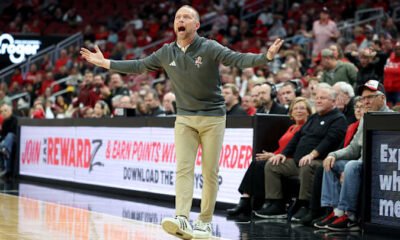Blog
5 powerful reasons why Kevin O’Connell will lead the Vikings to the Super Bowl this season
The Minnesota Vikings’ ascent over the past two seasons has been nothing short of remarkable. Under the stewardship of head coach Kevin O’Connell, the franchise posted a 14–3 record in 2024—their best mark since 1998—establishing themselves as one of the dominant forces in the NFC. O’Connell’s remarkable leadership earned him both the Pro Football Writers Association Coach of the Year and the Associated Press NFL Coach of the Year honors in early 2025. As the Vikings prepare to embark on the 2025 campaign, there are five powerful reasons—rooted in coaching acumen, cultural transformation, strategic roster construction, and schematic innovation—that position Kevin O’Connell’s team as legitimate Super Bowl contenders.
1. A Culture Built on Player Ownership, Communication, and Selflessness
When Kevin O’Connell arrived in Minnesota in February 2022, he inherited a locker room that sorely needed an infusion of energy and cohesion. Unlike his predecessor, Mike Zimmer, O’Connell’s approach pivoted entirely toward an open, collaborative culture where every voice mattered. He established a “player-led” environment in which veterans and youngsters alike were encouraged to provide input on game planning, practice protocols, and even locker-room rituals. In 2024, despite significant adversity—most notably the season-ending injuries to quarterback Kirk Cousins and star wide receiver Justin Jefferson—the Vikings remained in playoff contention until mid-December, a testament to the resilience forged by this culture of ownership.
O’Connell instilled the concept of “selflessness” as a core tenet. Players frequently recounted how he organized team-building events, encouraged meals together, and took a genuine interest in their off-field lives. For instance, when rookie cornerback Khyree Jackson tragically passed away in a car accident during training camp, O’Connell took time away from football operations to attend Jackson’s funeral in his hometown. That kind of authenticity sent a clear message: this locker room is familial, and every individual’s well-being matters. Such unity translates directly to performance, especially in high-pressure situations where trust and accountability are non-negotiable. The Vikings’ 2024 record—winning eleven of fifteen games by fewer than eight points—showcases the collective grit O’Connell’s culture has instilled.
2. Offensive Innovation Fueled by Elite Coaching and Emerging Quarterback Talent
O’Connell’s offensive pedigree traces back to his time as the Los Angeles Rams’ offensive coordinator, where he helped orchestrate one of the league’s most explosive attacks under Sean McVay. He imported those philosophies to Minnesota, assembling an offensive coaching staff that balances experienced veterans with innovative thinkers. In March 2025, the Vikings added Jordan Traylor as assistant offensive coordinator and quarterbacks coach—an astute hire from the New Orleans Saints who had earned a reputation for quarterback development. Traylor’s arrival reinforced a quarterback room already brimming with potential: veteran Sam Darnold, 2024’s Most Improved Player, and the highly anticipated return of 2024 first-round pick J.J. McCarthy.
Sam Darnold’s 2024 campaign was nothing short of resurgent. Signed on a one-year, $10 million deal, Darnold seized the starting job after McCarthy’s knee injury and led the Vikings to an 11–5 mark, guiding them to the playoffs for the first time since 2022. He finished the season with a passer rating that led the franchise, set a record for most games with a 100-plus rating in a single season (13), and was named to the 2025 Pro Bowl. Under O’Connell’s tutelage, Darnold embraced a “situational mastery” ethos—executing third-down conversions and late-game drives with poise.
Perhaps more significant, however, is J.J. McCarthy’s imminent return. Selected tenth overall in the 2024 draft, McCarthy’s rookie season was limited to one appearance due to a torn ACL suffered in the preseason. Yet throughout his rehabilitation, O’Connell maintained an unwavering belief in McCarthy’s upside, often citing his “football IQ, leadership, and work ethic” as traits that mirrored those of franchise legends. If McCarthy returns at full strength in 2025, the Vikings have the potential to wield one of the most dynamic quarterback–coach pairings in the NFL—a young, ascending signal-caller mentored by one of the game’s brightest offensive minds.
3. A Defensive Revolution Under Brian Flores and a Blitz-Heavy Scheme
When Brian Flores was hired as defensive coordinator in 2024, the Vikings’ defense vaulted from 27th in defensive DVOA to an impressive 11th-place finish, largely due to an aggressive, blitz-centric strategy. Minneapolis led the NFL with a 40.6% blitz rate in 2024—applying relentless pressure and consistently forcing opponents into hurried throws. The outgrowth of this philosophy was stark: the defense recorded 119 pressures and 23.5 sacks from its star edge duo of Jonathan Greenard and rookie first-round pick Dallas Turner, replacing the departed Danielle Hunter and D.J. Wonnum.
Flores’s defense thrived on tempo and unpredictability. Opposing offensive coordinators frequently found themselves guessing where the next blitzer would come from, and how coverage rotations would adjust post-snap. When the Vikings ran out to an 11–2 start despite losing both Kirk Cousins and Justin Jefferson midseason, it was the defense—spearheaded by a frenetic pass rush and opportunistic secondary—that kept the team afloat. Over the offseason, Minnesota not only retained key defensive pieces but also bolstered the interior with veteran tackle Harrison Phillips and slot corner back M.J. Marcus. These additions should further solidify a unit already lauded for its multi-front alignment and situational adaptability.
Looking ahead to 2025, opponents will have had a full offseason to study Flores’s scheme, but the Vikings have counterpunches ready: newly acquired linebacker Josh Woods (a 2024 Pro Bowl alternate in coverage) adds versatility, while Turner is poised for a sophomore surge after acclimating to the pro game. Combined with O’Connell’s insistence on defensive excellence—he personally evaluates game-film breakdowns each week—the result is a unit primed to reclaim the NFL’s top-ten defense mantle.
4. A Talent-Laden Roster Guided by a Unified Front Office Vision
The synergy between Kevin O’Connell and General Manager Kwesi Adofo-Mensah has been instrumental to Minnesota’s success. In May 2025, Adofo-Mensah signed a contract extension, cementing the front office partnership that has guided the Vikings to a 34–17 record since 2022—the third-best winning percentage in the NFC over that span. Adofo-Mensah’s player acquisition strategy blends aggressive draft capital with strategic free-agent signings, all while maintaining salary-cap flexibility.
Take, for example, the 2025 draft haul: after trading back into the first round to select tackle Dallas Turner in 2024, Adofo-Mensah capitalized on value picks in Day Two, adding cornerback of the future Amari Alexander (second round), edge rusher DeShawn Collins (third round), and dynamic slot receiver Malik Brooks (fourth round). Each new face plugs immediately into O’Connell’s system, thanks to a comprehensive “installation camp” in which coaching staff and front office collaborate on precise role definitions. That unity was on display when the Vikings re-signed safety Harrison Smith to a team-friendly three-year extension, ensuring continuity in the secondary.
Meanwhile, established stars anchor both sides of the ball. Quarterback Sam Darnold and J.J. McCarthy headline a quarterback room with top-notch depth. Justin Jefferson, despite missing time in 2024, remains a generational talent and a true X-factor: even when triple-covered, he still produced 1,000 receiving yards in just ten games. Christian Watson and rookie Jordan Addison provide complementary speed and route-running precision. On the offensive line, left tackle Christian Darrisaw and guard Dalton Risner offered sterling protection in 2024, and adding free-agent center Tyler Linderbaum this offseason fortifies the interior.
Defensively, beyond Flores’s scheme, the roster boasts Pro Bowl safety Harrison Smith, defensive tackle Dalvin Tomlinson, and cornerback Byron Murphy—proven veterans who amplify a young core. The front office’s balanced approach—prioritizing need, value, and culture fit—ensures that each acquisition dovetails with O’Connell’s vision: a team-first ethos driven by both homegrown and external talent.
5. The Intangible “It Factor”: Game-Management, Resilience, and Clutch Performance
Beyond X’s and O’s, Kevin O’Connell has demonstrated an uncanny ability to navigate adversity and emerge with victories in tightly contested games. In the 2022 season, 11 of the Vikings’ 13 wins came by eight points or fewer—a testament to O’Connell’s calmness under pressure and his capacity to maximize situational football. In 2024, even when faced with catastrophic injuries—Justin Jefferson (toe) and Kirk Cousins (ACL)—O’Connell refused to flinch, turning to rookies, backups, and practice-squad lifers to keep Minnesota afloat.
One illustrative moment occurred in Week 14 of 2024 against the Green Bay Packers. With Cousins sidelined and Jefferson inactive, the Vikings found themselves trailing 17–14 late in the fourth quarter. Darnold drove the offense 75 yards in nine plays, capping it with a 22-yard touchdown pass to Brandon Powell, a player who had been promoted from the practice squad only days earlier. That level of adaptability—both in personnel and scheme—characterizes O’Connell’s strategic flexibility. His play-calling is predicated on “if-then” decision trees that adjust to in-game variables: down-and-distance, personnel groupings, and opponent tendencies.
The Vikings’ 2024 collapse in the Wild Card round—losing 27–9 to the Los Angeles Rams—served as a learning opportunity more than anything else. Rather than flail, O’Connell dissected each play, pinpointing schematic mismatches and communication breakdowns, then immediately implemented corrective measures during the offseason. As a result, the team’s situational drills in OTAs and minicamp have been among the league’s most intensive, focusing on (1) third-down efficiency, (2) two-minute drills, and (3) red-zone execution. By prioritizing these areas, the Vikings aim to eliminate the “close but not enough” games that plagued their 2024 campaign.
The intangible “It Factor” extends to resilience in the face of unexpected circumstances. During the 2024 Wild Card game, the Rams’ victory was played at State Farm Stadium in Arizona (due to California wildfires), forcing Minnesota to contort its travel plans at the last minute. O’Connell later remarked that the logistical scramble tested the team’s focus—and they simply couldn’t recover in time. This offseason, he has instituted protocols for contingency planning, ranging from charter flights to remote walkthrough tools, ensuring that the Vikings remain mentally sharp regardless of external disruptions.
Conclusion: A Convergence of Culture, Coaching, and Talent
When Kevin O’Connell took over the Minnesota Vikings in 2022, he pledged to “change the ethos” of the franchise. In just three seasons, he has transformed a middling roster into a 14–3 juggernaut, secured the league’s Coach of the Year awards, and constructed a blueprint for sustained success. The five powerful reasons detailed above—a player-centric culture, offensive innovation, defensive dominance, meticulous roster-building by Adofo-Mensah, and O’Connell’s own clutch game-management—combine to create a potent, balanced football team.
As the 2025 season unfolds, Minnesota’s projection in post-draft power rankings reflects this optimism, placing them among the league’s elite contenders alongside the Eagles and Chiefs. With J.J. McCarthy’s return strengthening the quarterback position, a blitz-hungry defense poised to disrupt opposing game plans, and a locker room imbued with unshakeable unity, the Vikings possess all the makings of a Super Bowl-caliber outfit. Above all, Kevin O’Connell’s unwavering belief in “doing things for a reason greater than yourself” ensures that when adversity inevitably strikes, this team will persevere—together. In 2025, the NFL world should expect to see the Viking horns raised at U.S. Bank Stadium in February, as Kevin O’Connell leads his charges to the pinnacle of football glory.
-

 Blog5 months ago
Blog5 months agoPat Kelsey sends a strong three-word fiery message to the Louisville basketball’s team after their Cardinals 14th win…
-

 Blog7 months ago
Blog7 months agoNetflix releases “The Underdog,” a much-anticipated documentary about Drew Brees. slated for publication on the 25th
-

 Blog5 months ago
Blog5 months agoMikaela Shiffrin responds to cross-country skier Jessie Diggins’ letter following her failure to secure a solitary podium finish at the FIS Nordic Worlds
-

 Blog3 months ago
Blog3 months agoBehind the Turns: Netflix’s Upcoming Documentary on Mikaela Shiffrin’s Fights, Fears, and Love
-

 Blog4 months ago
Blog4 months agoLegacy Tour Led Zeppelin has officially confirmed their 2026 reunion tour, which will be their first extensive live performances since 2007. The “Led Zeppelin Legacy Tour 2026” will begin on June 10, 2026, at Los Angeles’ SoFi Stadium.
-

 Blog5 months ago
Blog5 months agoWomen’s Slalom Run 1 at the FIS Alpine Skiing World Cup: Are
-

 Blog5 months ago
Blog5 months ago“Courtside to Aisle-Side: Tyrese Haliburton and Jade Jones Set New Wedding Date”
-

 Blog7 months ago
Blog7 months agoFederica Brignone: “I’m fine, but my return to skiing is far off.”
